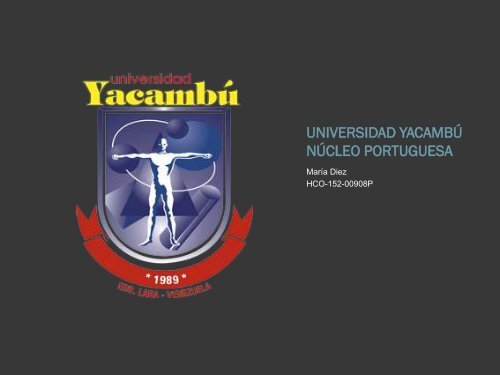You also want an ePaper? Increase the reach of your titles
YUMPU automatically turns print PDFs into web optimized ePapers that Google loves.
UNIVERSIDAD YACAMBÚ<br />
NÚCLEO PORTUGUESA<br />
María Diez<br />
HCO-152-00908P
1816<br />
Se inventa el<br />
heliógrafo en Francia.<br />
Las imágenes se<br />
obtenían a través <strong>de</strong><br />
una p<strong>la</strong>ca y <strong>la</strong> fusión<br />
<strong>de</strong> betún <strong>de</strong> Ju<strong>de</strong>a.<br />
Tardaba varios días<br />
en exponerse.<br />
Niépce y Louis<br />
Jacques Mandé<br />
Daguerre se asocian<br />
en<br />
sus<br />
investigaciones<br />
1829<br />
1832<br />
Muere Niépce,<br />
inventor <strong>de</strong>l<br />
heliógrafo y<br />
Daguerre queda a<br />
cargo <strong>de</strong> continuar<br />
con el <strong>de</strong>sarrollo <strong>de</strong><br />
los trabajos<br />
pendientes.<br />
Daguerre inventa el<br />
daguerrotipo,<br />
perfeccionando <strong>la</strong><br />
técnica <strong>de</strong> Niépce y<br />
reduciendo así el<br />
tiempo <strong>de</strong><br />
exposición a un<br />
día. Las imágenes<br />
ahora se<br />
reproducen en<br />
metales únicos.<br />
1838<br />
1839<br />
En Francia, gracias a<br />
Hippolyte Bayard, se pasa<br />
<strong>la</strong> captación <strong>de</strong> imágenes<br />
sobre p<strong>la</strong>cas al papel por<br />
una mezc<strong>la</strong> química.<br />
En Ing<strong>la</strong>terra, Fox Talbot<br />
inventa el Calotipo,<br />
permitiendo<br />
<strong>la</strong><br />
multiplicación <strong>de</strong> una<br />
imagen a través <strong>de</strong> su<br />
negativo.<br />
John Hershcell inventa el<br />
fijador fotográfico, que se<br />
usa hoy en día. Su función<br />
siendo eliminar <strong>la</strong>s sales<br />
<strong>de</strong> p<strong>la</strong>ta no reve<strong>la</strong>das pero<br />
que todavía están<br />
sensibles a <strong>la</strong> luz.
1840<br />
Llega Francisco<br />
Goñiz con su<br />
daguerrotipo a<br />
Venezue<strong>la</strong>. Después<br />
<strong>de</strong> quedarse 4<br />
meses, ven<strong>de</strong> su<br />
aparato y José<br />
Salva lo adquiere.<br />
Buscando cómo<br />
reducir el tiempo <strong>de</strong><br />
exposición, Fizeau<br />
reemp<strong>la</strong>za el ioduro<br />
<strong>de</strong> p<strong>la</strong>ta por el<br />
bromuro <strong>de</strong> p<strong>la</strong>ta por<br />
su sensibilidad a <strong>la</strong><br />
luz. Ahora sólo toma<br />
segundos obtener un<br />
daguerrotipo.<br />
1841<br />
1842<br />
El primer fotógrafo<br />
en Venezue<strong>la</strong> fue<br />
José Antonio<br />
González, oriundo.<br />
Ofrecía sus servicios<br />
como<br />
daguerrotipista en <strong>la</strong><br />
prensa.<br />
Abel Niépce, primo <strong>de</strong><br />
Niépce, substituye el<br />
papel por el vidrio<br />
para aumentar <strong>la</strong><br />
calidad <strong>de</strong>l trabajo.<br />
Utilizó albumina y<br />
obtuvo imágenes<br />
precisas.<br />
1847<br />
1851<br />
Scott Archer, inglés,<br />
prueba sacar <strong>la</strong><br />
albumina <strong>de</strong>l proceso<br />
para integrar el<br />
collodion. Consigue<br />
extraer imágenes<br />
mejoradas y<br />
<strong>de</strong>finidas.<br />
Por primera vez en<br />
Venezue<strong>la</strong> se<br />
p<strong>la</strong>sman imágenes<br />
en papel y se <strong>de</strong>jan<br />
<strong>de</strong> <strong>la</strong>do los<br />
daguerrotipos.<br />
1852
1860<br />
Inician los primeros<br />
pasos <strong>de</strong>l<br />
paisajismo en<br />
Venezue<strong>la</strong>, siendo<br />
Pal Rosti y Fe<strong>de</strong>rico<br />
Lessmann los<br />
pioneros <strong>de</strong> esta<br />
técnica.<br />
Gracias a Maxwell,<br />
comienza <strong>la</strong> presencia<br />
<strong>de</strong> los colores en <strong>la</strong><br />
<strong>fotografía</strong> dada su<br />
teoría <strong>de</strong> <strong>la</strong> radiación<br />
electromagnética.<br />
Ducos du Hauron,<br />
guiado por esto,<br />
experimenta con filtros<br />
<strong>de</strong> colores y realiza<br />
<strong>fotografía</strong>s. Luego<br />
superpuso <strong>la</strong>s tres<br />
imágenes<br />
y<br />
aparecieron todos los<br />
colores existentes en<br />
<strong>la</strong> captura.<br />
1869<br />
1880<br />
Se reemp<strong>la</strong>za el<br />
colodión por <strong>la</strong><br />
ge<strong>la</strong>tina en un<br />
intento <strong>de</strong> volver a<br />
reducir el tiempo<br />
<strong>de</strong> exposición.<br />
También se<br />
comienza a<br />
implementar el<br />
uso<br />
<strong>de</strong><br />
obturadores, pues<br />
<strong>la</strong>s p<strong>la</strong>cas <strong>de</strong> vidrio<br />
resultaban<br />
sensibles a <strong>la</strong> luz.<br />
George Eastman, <strong>de</strong><br />
Estados Unidos y<br />
fundador <strong>de</strong> Kodak,<br />
tiene <strong>la</strong> i<strong>de</strong>a <strong>de</strong> un<br />
soporte b<strong>la</strong>ndo. Las<br />
p<strong>la</strong>cas <strong>de</strong> vidrio<br />
comienzan a ser<br />
reemp<strong>la</strong>zadas por<br />
rollos <strong>de</strong> celuloi<strong>de</strong>.<br />
1888<br />
1889<br />
Aparece por<br />
primera vez en<br />
Venezue<strong>la</strong> <strong>la</strong><br />
<strong>fotografía</strong> en <strong>la</strong><br />
prensa,<br />
iniciando el foto<br />
reportaje.<br />
Gabriel Lippman<br />
promueve el<br />
medio <strong>de</strong> obtener<br />
<strong>fotografía</strong>s<br />
directamente en<br />
colores sobre una<br />
misma p<strong>la</strong>ca vía<br />
un procedimiento<br />
interferencial que<br />
ya prefiguraba <strong>la</strong><br />
holografía, sin<br />
embargo, <strong>la</strong> i<strong>de</strong>a<br />
no trascien<strong>de</strong> por<br />
su complejidad.<br />
1891<br />
1906<br />
Los hermanos<br />
Lumière logran <strong>la</strong><br />
síntesis <strong>de</strong> <strong>la</strong><br />
tricromía en una<br />
so<strong>la</strong> p<strong>la</strong>ca por<br />
medio <strong>de</strong>l<br />
añadido <strong>de</strong> un<br />
mosaico <strong>de</strong> micro<br />
filtros <strong>de</strong> tres<br />
colores a base <strong>de</strong><br />
granos <strong>de</strong> fécu<strong>la</strong><br />
<strong>de</strong> papa.
1908<br />
Se juntan <strong>la</strong><br />
<strong>fotografía</strong> y <strong>la</strong><br />
política en<br />
Venezue<strong>la</strong>. Luis<br />
Felipe Toro es el<br />
fotógrafo <strong>de</strong> Juan<br />
Vicente Gómez<br />
<strong>de</strong>s<strong>de</strong> que inicia su<br />
presi<strong>de</strong>ncia y hasta<br />
el día <strong>de</strong> su muerte.<br />
R. Fisher inventa el<br />
reve<strong>la</strong>dor cromógeno y<br />
es ahí cuando al<br />
fotógrafo se le permite<br />
<strong>la</strong> intervención en el<br />
reve<strong>la</strong>do, pudiendo<br />
hacer que un color<br />
predomine en <strong>la</strong><br />
imagen.<br />
1911<br />
1930<br />
Alfredo Boulton,<br />
Venezue<strong>la</strong>, es uno<br />
<strong>de</strong> los que inicia <strong>la</strong><br />
realización <strong>de</strong> <strong>la</strong><br />
<strong>fotografía</strong> artística<br />
<strong>de</strong>ntro <strong>de</strong>l país. La<br />
<strong>fotografía</strong> en estos<br />
tiempos es elitista,<br />
pues los equipos<br />
son costosos y su<br />
conocimiento era<br />
reservado.<br />
Kodak compra una<br />
mejoría técnica <strong>de</strong>l<br />
tri dada por dos<br />
estadouni<strong>de</strong>nses.<br />
Kodak, que fue<br />
fundada en 1888, se<br />
encarga hasta el día<br />
<strong>de</strong> hoy <strong>de</strong> <strong>la</strong><br />
distribución <strong>de</strong><br />
materiales y equipos<br />
fotográficos.<br />
1935<br />
1936<br />
La empresa<br />
Agfa, encargada<br />
<strong>de</strong> <strong>de</strong>sarrol<strong>la</strong>r<br />
productos <strong>de</strong><br />
sistema<br />
analógico toma<br />
<strong>la</strong> técnica <strong>de</strong>l tri,<br />
<strong>la</strong> pule y mejora,<br />
creando <strong>la</strong>s<br />
pelícu<strong>la</strong>s<br />
Agfacolor.<br />
La <strong>fotografía</strong> sufre<br />
una<br />
metamorfosis,<br />
pues en el 75,<br />
Russell Kirsch<br />
genera <strong>la</strong> primera<br />
imagen digital<br />
basándose en <strong>la</strong><br />
teoría<br />
fotoeléctrica <strong>de</strong><br />
Einstein. Las<br />
cámaras digitales<br />
tienen un sensor<br />
que convierte <strong>la</strong><br />
luz en cargas<br />
eléctricas.<br />
1975<br />
El hoy<br />
Los avances<br />
continúan y <strong>la</strong>s<br />
cámaras digitales<br />
siguen<br />
evolucionando en<br />
<strong>la</strong> búsqueda <strong>de</strong><br />
mejorar su<br />
imagen.



